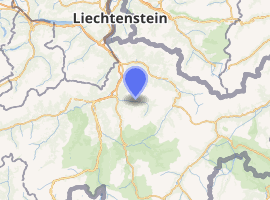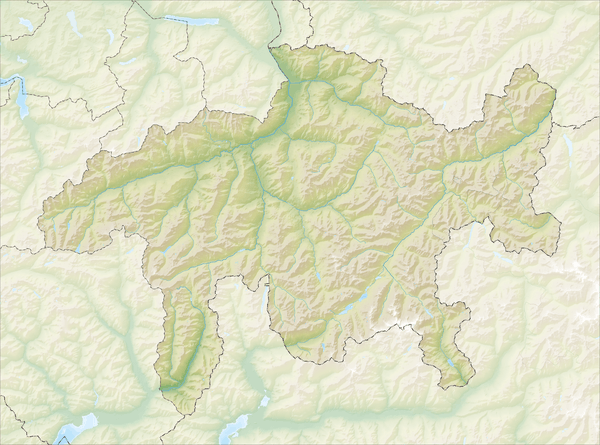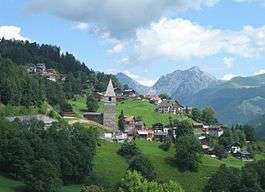St. Peter, Switzerland
St. Peter (Romansh: Son Peder) is a village in the district of Plessur in the canton of Graubünden, Switzerland. An independent municipality before, it merged on 1 January 2008 with neighboring Pagig to form the municipality of St. Peter-Pagig.[1]
St. Peter | |
|---|---|
 Coat of arms | |
Location of St. Peter 
| |
 St. Peter  St. Peter | |
| Coordinates: 46°50′N 9°38′E | |
| Country | Switzerland |
| Canton | Graubünden |
| District | Plessur |
| Area | |
| • Total | 690 km2 (270 sq mi) |
| Elevation | 688 m (2,257 ft) |
| Population (2007) | |
| • Total | 168 |
| • Density | 0.24/km2 (0.63/sq mi) |
| Postal code | 7028 |
| SFOS number | 3930 |
| Website | www SFSO statistics |
History
St. Peter is first referred to as a village in the late Middle Ages. The village church is first mentioned in 831. The church and the village section of Laeschgas belonged to Pfäfers Abbey.[2]
Geography

St. Peter has an area, as of 2006, of 6.9 km2 (2.7 sq mi). Of this area, 61% is used for agricultural purposes, while 30.1% is forested. Of the rest of the land, 4.2% is settled (buildings or roads) and the remainder (4.7%) is non-productive (rivers, glaciers or mountains).[3]
The village is located in the Schanfigg sub-district of the Plessur district in the northern slope of the mid-Schanfigg at an elevation of 1,160 m (3,810 ft). It consists of the village of St. Peter which is made up of two sections. In 2008 St. Peter merged with Pagig to form St. Peter-Pagig.
Nearby is the Sankt Peter-Molinis railway station, on the Chur-Arosa railway line, which also serves Molinis.
Demographics
St. Peter has a population (as of 2007) of 168, of which 15.5% are foreign nationals.[4] Over the last 10 years the population has grown at a rate of 8.4%. Most of the population (as of 2000) speaks German (95.5%), with Albanian being second most common ( 2.6%) and French being third ( 0.6%).[3]
As of 2000, the gender distribution of the population was 54.2% male and 45.8% female.[4] The age distribution, as of 2004, in St. Peter is; 7 children or 4.5% of the population are between 0 and 9 years old and 16 teenagers or 10.4% are between 10 and 19. Of the adult population, 13 people or 8.4% of the population are between 20 and 29 years old. 15 people or 9.7% are between 30 and 39, 25 people or 16.2% are between 40 and 49, and 26 people or 16.9% are between 50 and 59. The senior population distribution is 27 people or 17.5% of the population are between 60 and 69 years old, 19 people or 12.3% are between 70 and 79, there are 4 people or 2.6% who are between 80 and 89 there are 2 people or 1.3% who are between 90 and 99.[5]
In the 2007 federal election the most popular party was the SVP which received 67.9% of the vote. The next three most popular parties were the FDP (13.5%), the SP (9.3%) and the CVP (4.2%).[3]
The entire Swiss population is generally well educated. In St. Peter about 67% of the population (between age 25-64) have completed either non-mandatory upper secondary education or additional higher education (either University or a Fachhochschule).[3]
St. Peter has an unemployment rate of 0.43%. As of 2005, there were 6 people employed in the primary economic sector and about 2 businesses involved in this sector. 14 people are employed in the secondary sector and there are 3 businesses in this sector. 18 people are employed in the tertiary sector, with 9 businesses in this sector.[3]
The historical population is given in the following table:[2]
| year | population |
|---|---|
| 1808 | 197 |
| 1850 | 108 |
| 1900 | 115 |
| 1950 | 161 |
| 2000 | 154 |
References
- Amtliches Gemeindeverzeichnis der Schweiz published by the Swiss Federal Statistical Office (in German) accessed 23 September 2009
- St. Peter in German, French and Italian in the online Historical Dictionary of Switzerland.
- Swiss Federal Statistical Office Archived 2011-09-04 at the Wayback Machine accessed 28 October 2009
- Graubunden in Numbers Archived 2009-09-24 at the Wayback Machine (in German) accessed 21 September 2009
- Graubunden Population Statistics Archived 2009-08-27 at the Wayback Machine (in German) accessed 21 September 2009
External links
| Wikimedia Commons has media related to St. Peter-Pagig. |
- Official website (in German)
- Jürg Simonett: Sankt Peter (GR) in Romansh, German, French and Italian in the online Historical Dictionary of Switzerland.